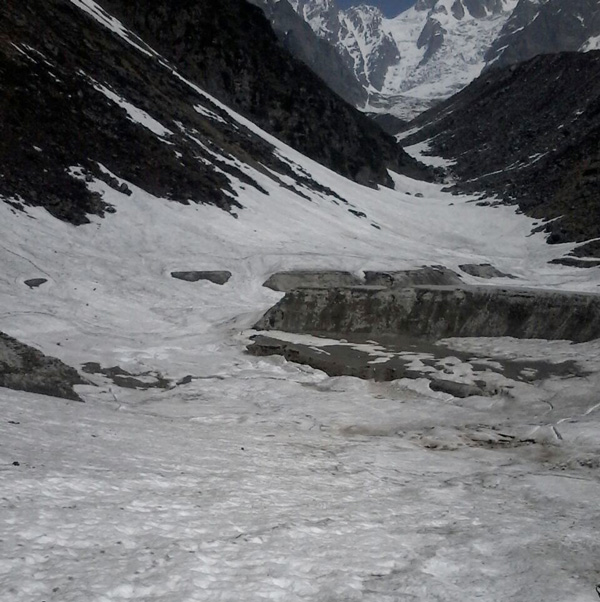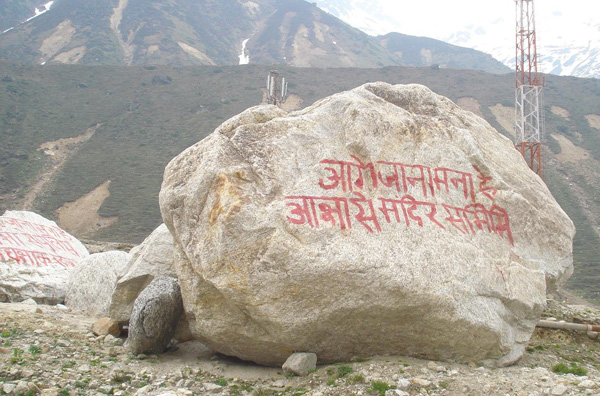Kedarnath lake, where Gandhi's ashes were immersed, wiped out

Tourist attraction
- A lot of pilgrims to Kedarnath used to visit the high-altitude Gandhi Sarovar lake behind the temple
- The lake offered a great view of the Mandakini valley
- It was one of the locations where Mahatma Gandhi\'s ashes had been immersed
Natural disaster
- The Gandhi Sarovar was wiped out in the Uttarakhand floods of 2013
- Water burst forth from the lake, causing flash floods in the valley
- It has now been replaced by flat ground and a small rivulet
Pilgrims to Kedarnath are familiar with the famous high-altitude lake behind the temple, the Gandhi Sarovar. This was one of the places where Mahatma Gandhi's ashes were immersed.
The Sarovar, also known as Chorabari in district Rudraprayag, was wiped off the map of Uttarakhand in the 2013 floods. The lake met the same fate as Rambara, a popular halting point on the trek to Kedarnath.
The triangular lake - roughly 250 metres long and 150 metres wide - had burst in the flash floods two years ago, and now, geological scientists say there is little to no chance of the lake's revival.
At present, the lake has been replaced by a small rivulet flowing down the Mandakini valley. The moraine deposit wall on the edge of the valley that had helped the lake store water got washed away in the floods.
Big tourist attraction
The Gandhi Sarovar was a big attraction for the pilgrims visiting Kedarnath. A major chunk of visitors would undertake the 3 km trek to visit the lake, which was situated at an altitude of 3,820m above sea level.
The Wadia Institute of Himalayan Geology, an autonomous body of the Department of Science and Technology (Government of India), has been monitoring the Chorabari glacier for the past 12 years. It says there's little chance of the lake being re-formed.
"In the present time, there's flat ground with a small rivulet on the spot where the lake existed. The glacier feeding the lake has receded further, affecting the water supply chain, and a major portion of this moraine-dammed lake got washed away in the 2013 flood. There is little chance of this lake's revival," says Dr DP Dobhal, geological scientist at the Wadia institute.

This is all that remains in 2015. Photo: Raju Gusain
Its significance
The Chorabari Lake was formed by the contact between a rock cliff and right lateral moraine, where drainage from the side valley was blocked to hold water. This lake was fed by rain, melting snow and avalanche material.
People began calling it the Gandhi Sarovar after the ashes of the Father of the Nation were immersed there. Though no documentary evidence exists for this in Kedarnath, it is widely held that the ritual was performed using an aircraft - which sprinkled the ashes in the lake.
The Gandhi Sarovar has been replaced by flat ground and a rivulet. There's little chance of revival
The Mahatma Gandhi connection gave it a new lease of life as a tourist attraction. The spot offered a great view of the water body, the Chorabari glacier and an aerial view of the Mandakini valley.
Recalling the craze for the lake, the Kedarnath temple's executive officer Anil Sharma said: "Over 10% of the pilgrims visiting Kedarnath used to go to Gandhi Sarovar. People from Bengal used to form a major chunk of such tourists."
The cause of the flash floods
The bursting of the Gandhi Sarovar was considered the main cause for the mass destruction in the June 2013 disaster. On 16-17 June, flash floods created havoc in the Mandakini valley, killing over 5,000 pilgrims in Kedarnath and leaving hundreds of devotees stranded.
Lake water mixed with debris and boulders rolled down the valley to cause mass destruction to property and human life.
After the 2013 disaster, the state government imposed a ban on the trek to Gandhi Sarovar, which is still in place. Pilgrims visiting Kedarnath can see instructions painted in red on boulders, cautioning them not to proceed uphill from the Kedarnath shrine onwards.

Photo: Raju Gusain
This instruction, issued by the Badrinath Kedarnath Temple Committee, a government body managing the shrine, can be found on many boulders lying behind the temple.
These days, the Nehru Institute of Mountaineering (NIM), the agency doing reconstruction work in the flood-ravaged Kedarnath region, is constructing a protective wall behind the ancient temple devoted to Lord Shiva. Pilgrims touring the valley get a glimpse of the reconstruction work being done in Kedarnath township.
Hundreds of boulders, carried by the floods, are scattered behind the shrine - a stark reminder of the gravity of the disaster.
NIM's media co-coordinator Amud Panwar says: "The 2013 flash floods have damaged the trek route to Gandhi Sarovar, so the pilgrims are not allowed to go there. Those keen on going need to go under NIM supervision."
First published: 1 October 2015, 7:08 IST





![BJP's Kapil Mishra recreates Shankar Mahadevan’s ‘Breathless’ song to highlight Delhi pollution [WATCH] BJP's Kapil Mishra recreates Shankar Mahadevan’s ‘Breathless’ song to highlight Delhi pollution [WATCH]](https://images.catchnews.com/upload/2022/11/03/kapil-mishra_240884_300x172.png)

![Anupam Kher shares pictures of his toned body on 67th birthday [MUST SEE] Anupam Kher shares pictures of his toned body on 67th birthday [MUST SEE]](https://images.catchnews.com/upload/2022/03/07/Anupam_kher_231145_300x172.jpg)






